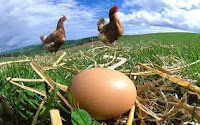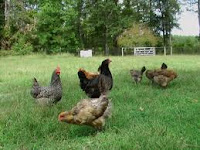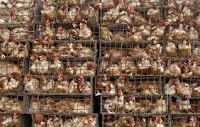cock crowing, and scrambling some eggs laid by either "Rosie" or "Ethel" who live in my back yard, with maybe a drop of milk from "Daisy" the cow or "Sally" the goat - a dream of pastoral bliss.
Today my story is not about Daisy and Sally, their story will come later, but about Rosie and Ethel the hens (who in my scenario of pastoral bliss are the lucky ones) and their 280 million cousins living in the U.S. (who are not so lucky).
This story begins with "the birds and the bees", and a brief overview of the what, why, and how of eggs. An egg is a hen's external ovulation and whether it turns into a chick depends whether it is fertilized by a cock ('rooster'). So generally speaking if you are keeping hens for eggs you need to keep the cocks well out of the way until you want some babies. A hen does not necessarily lay every day and, without going into too much detail, the frequency of laying is due to the time it takes for the hen's yolk to make its way down the oviduct, go through the various processes of being encased in its protective membrane, and finally enclosed in its hard shell before it is laid. As a guiding average a hen will lay two eggs every 3 days so that's why you need a few hens if you want your daily scramble. A hen likes to lay her eggs in 'clutches' (batches) and clutch sizes can vary on average from around 12 to 20. In the natural world a hen will become broody when she has sufficient eggs in her nest and will sit on the clutch to incubate the eggs, whether they have been fertilized or not. Some breeds get more broody than others and farmers will discourage an overly broody hen as she will not be an efficient layer. On the flip-side of the natural v. unnatural world: as a consequence of genetic engineering in industrialized farming, 'factory' hens have had all the broodiness engineered out of them. As a farmer friend said to me recently, chickens in factory farms don't know how to be chickens any more.
Now, from time immemorial farmers have been practicing selective breeding and cross breeding to produce the best hybrid hen that is a great layer, adaptive to its climate, and a good forager (this keeps the food bill down and the hen and her egg healthy) - this is part of animal husbandry. Farmers and backyard chicken raisers have used many methods to increase and maintain a good yield of eggs. Going back to our hen biology lesson: egg laying is part of the reproductive system and is therefore stimulated by hormone levels; hormone levels are influenced by the pituitary gland (the master gland), and the pituitary's efficiency is stimulated by sunlight - so to cut to the chase - the more daylight a hen gets the more she will lay. This means that in the summer her laying is higher than in the winter months when the days are shorter. Farmers have been manipulating this fact for decades to ensure a steady annual flow of eggs and have provided 'daylight' lamps in hen coops, probably since the invention of electricity.
A hen's diet is important for peak health and peak laying conditions and she is an omnivore by nature, and will balance her diet naturally when she is allowed to forage, scratch and peck for grass and insects...and all the stuff that the bigger foragers leave behind. Depending on the quality of the land and time of year, pasture raised hens may need some chicken feed - but this is supplementation and doesn't constitute the full body of the birds' diet.
So we can see that to get the most desirable qualities out of his hens a farmer has a few tools at his disposal. He can pasture his chickens thereby keeping the chicken food bill to a minimum, rely on selective/cross breeding to produce a chicken that is going to be a good layer, maintain 14 hours of daylight year round to ensure a more consistent supply of eggs, and most importantly be cognisant of the health and welfare of his birds.
A humanely raised hen will provide a good number of eggs each year - 200 -300. Just a few chickens will provide a daily egg or two, enough for friends and family, and a decent size flock will ensure a commercially viable egg business - all from happy hens.
Now over to the industrialized cousins, the breed known as "the layers". A very different story (and a very different egg).
The factory-farmed layer has a more miserable existence than its industrialized counterpart - "the broiler" - impossible as this may seem (check out the plight of the broiler chickens in "Finger Lickin' Good")
So how can this be? Answer: the hens in the egg industry are simply vessels for the final product - their welfare is of absolutely no importance, and veterinary care is non-existent as the birds are cheap and expendable. "They suffer from blisters, tumors, foot and leg deformities, Fatty Liver Syndrome, Swollen Head Syndrome, heat stress, mold toxins, mouth ulcers and many other diseases.
Birds too sick to lay eggs are thrown onto the "dead-pile" and sometimes in the manure pit - dead or alive.
Currently there are more than 280 million laying hens in the U.S. living in these unsanitary, inhumane and cramped conditions inside metal cages; ninety-five percent of the eggs available in the U.S. come from these "houses of horror". Hens are squeezed between four to six in a cage, with each one recieving a space just half the size of an A4 sheet of paper. The hens stand on the thin wire of their cages their whole lives, the metal often cuts into their feet and it is not uncommon for their claws to grow around the metal wire. The hens can barely turn around and certainly cannot stretch their wings, and they must stick their heads through the wire mesh of the cage to reach water and feed. The cages are stacked one on top of each other and their bodily excrements pass through the cages into manure pits at the bottom of the tiered cages.
Toxic ammonia fumes rise from the decomposing uric acid in the manure pits beneath the cages resulting in eye problems and chronic respiratory disease in millions of battery hens, and from a human health standpoint studies have shown that even at low concentrations significant quantities of ammonia can be absorbed into the egg. A day in the life of an industrialized laying hen is the same as it was yesterday and the same as it will be tomorrow - cramped, uncomfortable, boring at best and excruciatingly painful at worst.
A Day in the Life of a Battery Hen: "It is summer, and the hen feels too warm, and uncomfortable. Her instincts tell her to scratch out an area of fine, dry soil and dustbathe in it to keep cool. She is so desperate to do this that she goes though the motions on the bare wire floor of the cage lying on her side, scratching the cage floor, rubbing her head and neck on the floor, opening her wings and damaging her feathers. But she cannot dustbathe, so she simply pants to dissipate heat and takes out her frustration on her four cage-mates by pecking them" -
Naturally the hens become bored and aggressive - who wouldn't - cooped up in claustrophobic cages; and so industrialized chicken producers have chosen to minimize the problem of fighting by debeaking and toe trimming.
These mutilations are carried out without the use of anaesthetic and are extremely painful procedures for the chicks, and the birds continue to suffer pain and problems with their shorn beaks for the remainder of their lives.
A factory farmed hen is genetically engineered and environmentally manipulated to lay many more eggs than nature intended. A hen starts life with all the makings of thousands of undeveloped eggs inside her body - more than she will ever lay: (now, to my unscientific brain, I wonder - is this is one of the aspects of hens' biology that the scientists harness when they genetically engineer hens to lay more than they would in natural circumstances?) Whatever/however, it goes without saying that this excessive laying creates untold hardships on the hens. Shells are made up of calcium which the hen provides from her skeleton, but her expenditure of calcium far exceeds her 'income' and factory farmed hens suffer from osteoporosis, with their legs becoming "so brittle they snap like twigs".
When a hen's egg production slows down it is often forced into a laying bonanza through a cruel system known as 'forced-molting'. A system so cruel that it has been banned in most European countries for the last twelve years. To explain what forced-molting is I need to go back to the biology lesson. Like other birds the hen goes through a molting period once a year. During molting the hens will stop laying, then, when the lost feathers have been replaced the hen will resume laying with vigor. So industrial chicken producers capitalize on the post-molting period by tricking the hen's body into a non-seasonable molting through manipulating her hormones. How do they do this? Answer: through food deprivation (average 12 days) and water deprivation (3 days - any longer and they would die).
The vigorous post-molting laying eventually slows down and so the hen can be put through this procedure more than once until the producer is sure she is spent, then she wil be slaughtered and what little flesh is remaining on her frame will most likely end up in baby food. Needless to say 'forced-molting' causes tremendous stress and suffering for the hen, and the United Poultry Concern has campaigned long and hard to get a ban on this practice. Fortunately the USDA has enforced some changes to this practice, but unfortunately these changes have not gone far enough - rather than being completely starved the hens are now semi-starved through an administration of minimum amounts of nutrients and a little water. Still extremely undesirable but hopefully a step in the right direction toward a total ban on the practice.
As I pointed out earlier a hen's laying cycle is dependent on daylight and farmers provide lamps to maintain 14 hours of daylight steadily throughout the year to maintain a regular supply of eggs. Being concerned about the welfare of the hens we asked Matthew O'Hayer from Vital Farms how demanding was this 'year-round summer' to the hens. He assured us in an email that from an "animal welfare standpoint...I have not observed a difference between hens that are provided with supplemental lighting and those that are not...Also organizations like Certified Humane and Global Animal Partnership...have not noted any issues pertaining to such small amounts of extended lighting". During the hours of darkness, the hens reproductive system slows down and results in the average 2 eggs every 3 to 4 days that I mentioned previously.
The difference for factory-farmed hens is that for them the lights never go out, and the hens' "reproductive organs [are] ravaged by the continuously burning light bulbs in the [sheds] to which hens' bodies respond involuntarily by trying to form eggs [in this permanent 'daytime']" - United Poultry Concerns.
Have you ever wondered what happens to the male chicks that are born in the industrialized egg industry? Only a very small number are needed for their semen supply; so being superfluous to needs, day old male chicks are thrown live into a grinding machine and macerated for fertilizer (picture a wood chipper and you get an idea), or else they are dumped into plastic bags and allowed to die of suffocation or dehydration in dumpsters.
Leaving aside the animal welfare aspects of factory farmed 'layers' for a moment, what about the end product of all of this - the eggs themselves? Eggs have been given a bad rap over the years because of their purported high cholesterol content, however, eggs produced by naturally pasture-reared hens are healthy and have the right balance of the essential fatty acids of omegas 3 and 6. The health problems arise from eating the unhealthy eggs produced by hens raised on unnatural diets in an unnatural habitat. Factory eggs are much higher in omega 6 and because the Standard American Diet is already too high in omega 6 (15-20 times higher than it ought to be) there is a serious imbalance that can lead to heart disease, high cholesterol, and many of our degenerative diseases.
So whatever our concerns are - animal welfare or a quality product - we have to change the way our eggs are produced. So what can we do to help change the face of the egg industry? Change begins at the grass roots level with the consumer. Consumers can demand ethically and humanely raised eggs with their food dollar by buying pasture raised eggs from supermarkets and farmer's markets. Consumers need to get to know their local egg farmer, research egg suppliers and find out the farmers/producers who are pasture raising their flocks sustainably and humanely. This information is available from websites such as Animal Welfare Approved, Eat Wild, American Grass Fed, and Local Harvest. One national supplier who has a top billing from the Cornucopia Institute and Wholefoods 5-Step Rating System is Vital Farms. Whenever you see Vital Farms stamped on the egg carton you can be rest assured that you are buying a quality product that has been humanely and sustainably produced.
Buy pasture raised eggs, and support animal welfare groups such as Compassion In World Farming and Vital Awareness to help us in the campaign to change the way our food is raised and produced.
Producers such as Vital Farms have proven that ethical, humane and sustainable egg production on a larger scale is possible, and can still be a viable and profitable business. With the right farming practices everyone and everything benefits - from the farm animals to human and environmental health.
Make sure that your morning 'sunny-side up' is truly the sunny-side up.
- THE ACTIVIST











this makes me sick i am 16 years old and now i for sure am never eating chicken unless its from a farm ever agin
ReplyDelete